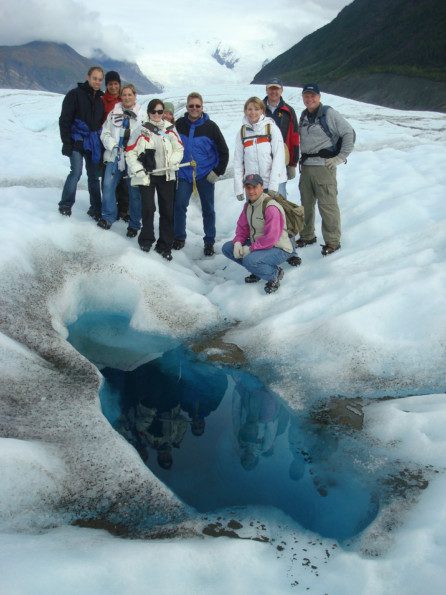McCarthy, Kennicott & Wrangell-St. Elias: A Motherlode of Magnificent Mountains and Alaska Mining History
Located at the end of one of Alaska’s roughest rural roads, and set deep in the Interior and mountainous wilds of America’s largest national park, the 13.2 million acre Wrangell-St. Elias National Park has two tiny towns with one big history: Kennicott and McCarthy. This is where Alaska’ past meets present, where you can truly appreciate off-the-grid while still being on the grid, and where adventures come in all sizes. Here you can experience Alaska’s mining history, explore its big glaciers and bigger mountains, seek out quiet hikes and camping, and take some seriously heart-pounding rafting outings.
Today, you can practically count the area’s residents using all of your fingers and toes. This is a far cry from the mining madness of the early 1900s, when Kennicott (also referred to as Kennecott, which was the name of the area’s copper company) and McCarthy were abuzz with activity and where miners came to bring their dreams of riches to reality.
Back then, this was the world’s richest copper-mining hub – hundreds of thousands of pounds of copper were being pulled from the rugged surrounding area, netting hundreds of millions of dollars. Kennicott was where the miners worked; McCarthy is where they played – and presumably fought over gambling debts, mining claims, lovers and booze.
You can learn a lot of about Alaska’s mining past, and the resilience and resourcefulness of miners in a very short time by visiting both towns, which are separated by about five miles and connected by an old dirt road. Kennicott is now something of a living mining museum with amazing mining structures standing tall – some restored, some dilapidated. The 14-story Mill Building of the Kennecott Copper Corporation is the area’s gem.

Alaska’s Historic Kennecott Mine
Meanwhile McCarthy remains the center of daily life for modern residents and visitors. It’s retained its old-school-Alaska, turn-of-the-century charm and much of its storied past is preserved, especially at a must-see museum. McCarthy is also where most visitors can stay at a handful of lodging establishments, as well as eat and even have a sip of whiskey or beer like the old timers.
While copper is beautiful and stories of hearty Alaskan miners are often romantic and inspiring (and sometimes tragic), the area’s greatest feature is its surroundings: massive glaciers, mountains, and dense wilderness spans as far as you can see in every direction. Wrangell-St. Elias National Park and Preserve is where four major mountain ranges meet, some of the nation’s tallest mountains stand, and grand glaciers glimmer. The Park attracts elite climbers, weekend warriors, curious travelers and those looking to get deep into nature.
In McCarthy, experienced local guides are ready to take you on any type of adventure you’d like: an informative and memory-card filling historic tour of the mining areas; a walk on a nearby glacier; a hike to an old mining site and beyond; a campsite far away; a wild water rafting ride down a glacier-fed river filled with Class II and III rapids; or an unforgettable flightseeing to float above it all. Root Glacier hiking is a favorite, where you can expand your glaciology and geology knowledge and see glacial streams cutting deep ravines and waterfalls into the ice.

Root Glacier hike from Kennicott, Alaska
As mentioned above, Wrangell-St Elias National Park isn’t so easy to get to – but that’s part of its allure and attraction. It takes 6-8 hours of driving from Anchorage and Fairbanks to reach McCarthy-Kennicott. The rough McCarthy Road comprises the last two hours; it’s so rough, in fact, that most rental car companies forbid you to drive their vehicles on it! No worries as you can fly into the area from nearby Chitina, avoiding the toughest stretch of road. If you do drive, you’ll be surprised to see that the end of the road is actually just before McCarthy, where a footbridge over a river takes you into town. No outsider vehicles are allowed here; a bus service will get you from one town to the other, though. For those who crave excitement as well as for those who appreciate the quiet and unique landscapes of Alaska’s wilderness, the journey to get to Wrangell-St. Elias is worth every mile.
